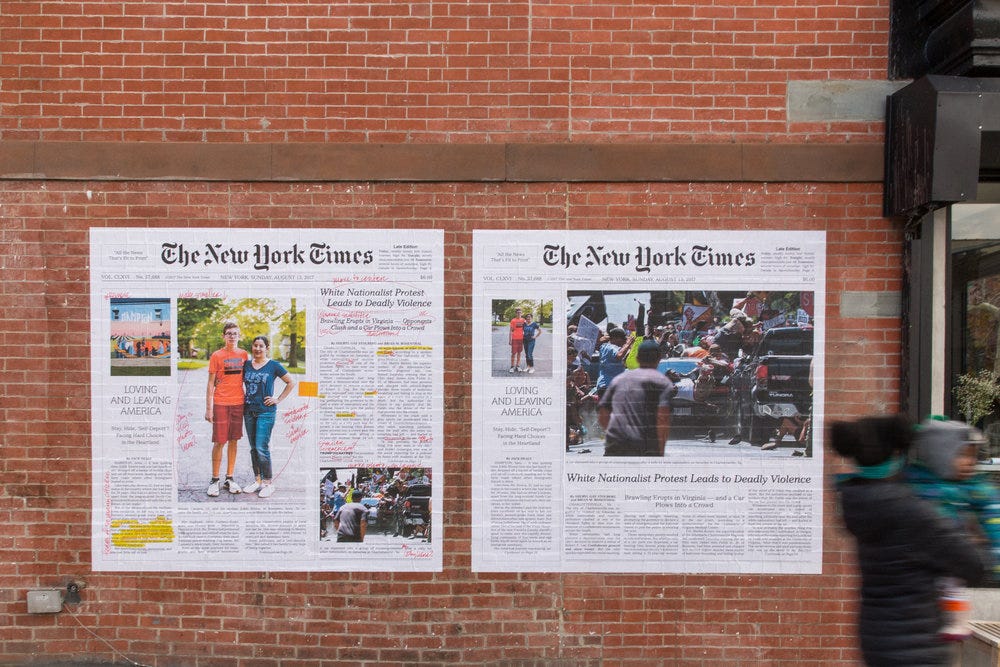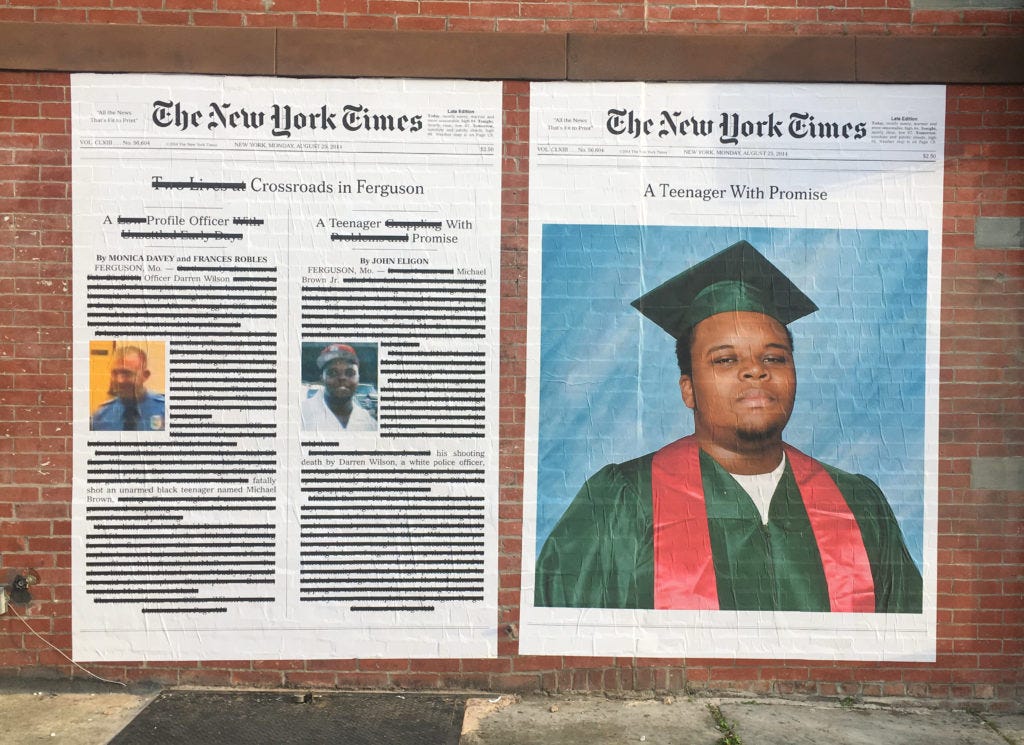I realise that mention of Harry and Meghan might make many of you roll your eyes. But stick with me, I’ll get to the art. By now the details of what has emerged from the recent Netflix documentary, Prince Harry’s TV interview and his autobiography are well known to anyone who has been paying attention to this particular news story: family arguments and rivalry; the realities of how the British tabloid press are briefed on royal stories; how the trauma of his mother’s death has profoundly affected Harry throughout his life; the sadness and frustration of a life lived as the royal ‘spare’; a delightful love story; Harry’s angry crusade against the intrusive British tabloid press etc. Lines have been drawn, sides have been taken.
It’s a dramatic story and one which will no doubt be turned in to a movie eventually. But for me the most interesting element of the whole thing, what I think is the key takeaway for us to think about and address, has been buried in all the sensational drama: the continuing issue of racial bias in British and American mainstream news media that contributes to the unequal dynamics of power in society.
In one of the episodes of the Netflix documentary the couple demonstrate the negative ways in which Meghan’s ethnicity has been represented in the media since the news of their relationship first broke. It’s something the couple also talked about in their interview in 2021 with the American talk show host Oprah Winfrey.
If you haven’t watched or seen any of this negative coverage in the news, here’s just a snippet of how Meghan has been represented. She was described as ‘(almost) straight outta Compton’ by The Mail Online; at about the same time The Daily Star ran a headline asking whether Harry would ‘marry into gangster royalty?’; another Daily Mail journalist talked about her ‘exotic DNA’; a BBC presenter compared their son Archie to a chimpanzee.
This kind of language ‘others’ people by skin colour and peddles harmful stereotypes. But racism is not always overt in the mainstream news media. A lot of it is subtle, appearing as negative comparisons using image-positioning and choice of words. Compare Meghan’s coverage to the way in which the future king William’s wife Kate is discussed in the news media, for example. Kate = good, Meghan = threat.
As the academic Dr Maya Goodfellow argues, this goes way beyond Meghan - it’s about how these negative representations are ‘quietly shaping the way people are seen, talked about, and treated’ in a wider social context. It has an impact on people’s lives.
Whilst much of Harry’s ire is directed at the British tabloid press, racial bias in the mainstream news media is not uniquely a British phenomenon. It’s a subject that the American artist Alexandra Bell deals with in her work. Bell has journalistic training and her art practice addresses how race and politics have been represented in newspapers historically. She draws attention to the space allowed in the press for particular stories, the positioning of images and the words chosen to describe events.
Back in 2017 Bell started a series of works called Counternarratives, in which she analysed articles from The New York Times to question the deliberate choices that are made in newsrooms. She selected different images and moved their placement on the page as well as changing the words used in these articles.
A Teenager With Promise is one of several works that powerfully represent the ideas about media bias Bell is interested in exploring. In this artwork she focused on the coverage of the shooting of an unarmed young black man, Michael Brown, by a white police officer during a summer of protests in Missouri in 2014. On the left, the original article after her process of redacting phrases that contribute to negative interpretations of the young man. On the right, a mocked up version of how the story might be presented in an entirely different light.
Bell reproduced the artworks on a large scale and pasted them up on walls in New York so that the images appeared more urgent and grabbed the attention of passers-by. In this video she explains the process and thinking behind the artworks, the placement of them in the street, and the way in which visuals and particular words have an enormous impact on the way in which stories are received. It’s 8 minutes, and well worth a watch.
Bell’s work is not an indictment of the mainstream news media but rather it asks us as viewers to think about the ways in which power operates in this context and how the press reflects and reinforces patterns of thinking in our society to the detriment of certain groups of people.
In Britain at least there has been some movement towards acknowledging that there is a problem. In August 2021 The Society of Editors withdrew the claim that the UK media is not racist following months of pressure from journalists of colour who said it did not reflect their experience of the industry. British newspaper editors have apparently made a commitment to diversify their newsroom staff in an effort to improve things.
But just last month the journalist Jeremy Clarkson at The Sun wrote of Meghan that he was ‘dreaming of the day when she is made to parade naked through the streets of every town in Britain while the crowds chant 'Shame!' and throw lumps of excrement at her’. Articles like this demonstrate how low the priority of tackling racial bias in the media is. Let’s face it, comments like Clarkson’s make newspapers money so it makes financial sense for editors to run them. Plus plenty of people agree with his views.
How we collectively address this issue needs consideration. But I do believe that artists like Alexandra Bell have a really important role in communicating uncomfortable truths in a way that makes sense, connects emotionally and educates people.
I’d love to know what you think about this so please leave a comment below.
Artists From The Gallery Companion Reader Community
This week I’m introducing a new feature in my Wednesday posts: a spotlight on the work of artists from The Gallery Companion’s readership. My emails go out to thousands of readers, a mix of artists and art lovers. So I hope this will be a great way to introduce the huge pool of talent amongst you to each other and to new audiences. This week, two artists from different sides of the Pond.
Mary Jo Matsumoto

Mary Jo is an American artist of Japanese heritage. Her paintings, drawings, and sculptures embody her experiences as a mixed-race woman living in the USA. Underlying her work is a deep interest in family history and erased cultural identity, in uncovering secrets and examining things that go unsaid. I spoke with Mary Jo about her practice earlier this week:
See more of Mary Jo’s work on her website and follow her on instagram
Martin Cody
Martin is a sculptor living and working near the cathedral city of Wells in the south west of England. He is an improvisor at heart, interested in exploring the possibilities for materiality. Martin’s constructed sculptures are made up of distributed forms and modulated surfaces, lines, clusters, blocks, edges, contours, profiles and intervals. I’ll be talking to Martin later in the year about a new body of work he is developing.
See more of Martin’s work on his website and follow him on instagram





Need Help Writing About Your Art?
Do you struggle to communicate your ideas in words? Does the thought of writing an artist statement make you want to pop your head in the sand? Would you like someone to help you tease out connections and think through the ideas you’re exploring? I can help you! As a writer and university lecturer I’ve been guiding artists on how to think through their ideas and put them into coherent words for over 15 years. Contact me for a focused and constructive 1-2-1 discussion about your art. Here’s a link to more info or reply to this email to discuss what you need and to see if we’re a good fit.
Thanks for reading! Please share my emails with anyone you think would also enjoy them. This word-of-mouth support is like gold to me, and I appreciate it enormously. The more people know about it, the stronger this community will become.





Such an interesting situation with H&M, with various facets. I do think they’re helping to widen the cracks that already exist all over that particular institution. And through the cracks you can really start to sense ‘the beast’ clutching as hard as it can onto the Crown, that dreaded symbol of inauthentic leadership.
The comparison of media coverage between the 2 duchesses that H&M highlighted in their Netflix interview was, for me, really important. I think it’s helping to raise awareness of our over-reliance on the biased media to form personal views. I think Alexandra Bell’s work that you’ve shown us here is a powerful and effective way of focusing attention on this issue - particularly with regard to racism. A wake-up call.
The ability to remain critical is such an important one and fortunately can be backdated - we can question the views we were raised with as children which we unconsciously carry around with us as adults. I think Harry’s teaching us that tradition can and should be broken down where it’s become dehumanised.
Thank you for bringing this up. I was starting to roll my eyes at the drama of it all but this has saved it and put it back in the realms of education.
This type of school lesson of analyzing media and creating a counter-narrative can't be done enough! Kids (or uni students) learn from the inside out and their perspectives are still so malleable. I like the way you describe the way the media makes a simple 'good / bad' binary; it's true! It's easy to ingest news and not work with nuanced views or breakdown dichotomies if one is presented with such forms of journalism. Art works in the in between, and good journalism is art. The most dangerous thing a teacher can do is reinforce the good/bad or black/white oppositions, perhaps without meaning to, by simply presenting the other side. I haven't watched the show yet but want to and am much more interested to do so now.